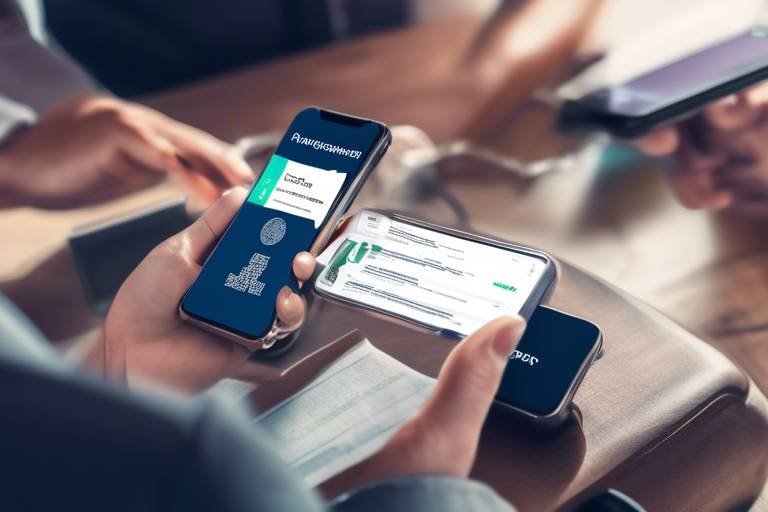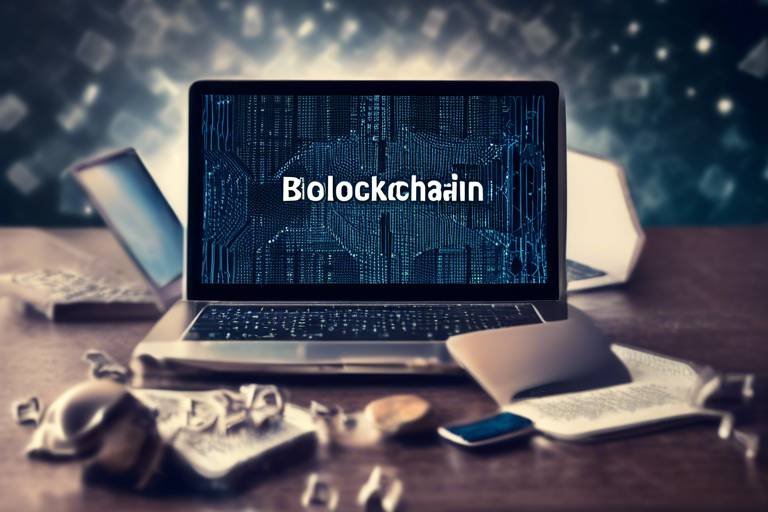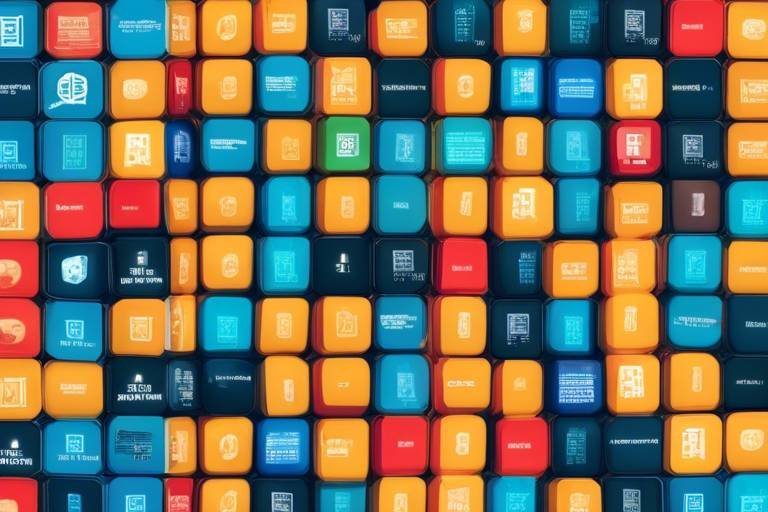How to Educate Your Community About Blockchain Technology
In today's fast-paced digital world, blockchain technology has emerged as a revolutionary force, promising to change the way we conduct transactions, share information, and build trust. However, despite its potential, many people remain in the dark about what blockchain really is and how it can benefit their lives. This article explores various strategies to effectively educate communities about blockchain technology, its benefits, and its applications, fostering a better understanding and encouraging adoption among diverse audiences.
A foundational understanding of blockchain technology is essential. Think of blockchain as a digital ledger, much like a notebook that records transactions. However, unlike a traditional notebook, this one is decentralized and distributed across a network of computers, making it incredibly secure and transparent. Key concepts include:
- Blocks: These are the individual records that contain transaction data.
- Chains: Blocks are linked together in chronological order, forming a chain.
- Decentralization: No single entity controls the entire network, which reduces the risk of fraud.
- Consensus Mechanisms: These are protocols that ensure all participants agree on the validity of transactions.
By breaking down these concepts into digestible parts, you can help demystify this complex subject and make it accessible for beginners.
Recognizing the specific groups within your community is crucial for effective education. Not everyone has the same level of understanding or interest in blockchain technology. Consider segmenting your audience based on:
- Interest Level: Are they technology enthusiasts, business owners, or simply curious individuals?
- Knowledge Level: Are they complete beginners or do they have some prior knowledge?
- Potential Use Cases: How could they benefit from blockchain? For example, artists might be interested in NFTs, while businesses might focus on supply chain management.
By tailoring your educational content to different segments, you can ensure that your message resonates more effectively.
Organizing workshops and seminars can significantly enhance community engagement. These events provide a platform for interactive learning, where participants can ask questions and engage in discussions. Here are some best practices for planning and executing educational events:
- Choose the Right Format: Decide whether you want a hands-on workshop, a lecture-style seminar, or a panel discussion.
- Invite Experts: Bring in knowledgeable speakers who can provide insights and answer questions.
- Interactive Activities: Incorporate group activities or demonstrations to keep participants engaged.
By creating an inviting atmosphere, you can foster a sense of community and encourage participants to share their thoughts and experiences.
In the digital age, online platforms are invaluable for education. They allow you to reach a broader audience and provide resources at their fingertips. Consider using:
- Social Media: Platforms like Twitter, Facebook, and LinkedIn can be used to share articles, infographics, and videos.
- Webinars: Host online seminars to discuss various blockchain topics, allowing for real-time interaction.
- Online Courses: Create structured courses that participants can take at their own pace.
Utilizing these platforms can help disseminate blockchain knowledge effectively while catering to different learning preferences.
Content creation is key to educating your community. Think of it as building a bridge between complex blockchain concepts and your audience's understanding. You can develop:
- Articles: Write engaging blog posts that explain blockchain in simple terms.
- Videos: Create visual content that illustrates how blockchain works.
- Infographics: Design easy-to-read graphics that summarize key points.
By simplifying complex ideas and encouraging community interaction, you can make learning about blockchain a fun and engaging experience.
Partnering with blockchain experts can enhance credibility and provide valuable insights. Engage local professionals for:
- Talks: Invite them to speak at your events.
- Mentorship: Create mentorship programs where community members can learn directly from experts.
- Collaborative Projects: Work together on projects that demonstrate blockchain applications in real-world scenarios.
This collaboration not only enriches the educational experience but also builds a network of knowledgeable individuals within the community.
Practical experience solidifies understanding. Encourage hands-on learning opportunities, such as:
- Hackathons: Organize events where participants can work on blockchain projects.
- Coding Workshops: Teach community members how to develop their own blockchain applications.
By providing these opportunities, you allow community members to apply blockchain concepts in real-world scenarios, making the learning process more impactful.
Assessing the effectiveness of educational initiatives is vital for continuous improvement. Consider methods such as:
- Feedback Surveys: Collect participant feedback to understand their learning experience.
- Knowledge Retention Tests: Measure how much participants have learned through quizzes or assessments.
- Community Engagement Metrics: Track community involvement and interest in blockchain over time.
By evaluating these aspects, you can refine your educational strategies and ensure they meet the community's evolving needs.
Creating a long-term educational framework ensures ongoing community engagement. Consider strategies for developing and maintaining a sustainable program, such as:
- Regular Updates: Keep your content current with the latest advancements in blockchain technology.
- Community Involvement: Encourage community members to contribute to the program, fostering a sense of ownership.
- Partnerships: Collaborate with local organizations and schools to reach a wider audience.
By implementing these strategies, you can create a vibrant educational ecosystem that adapts to the community's needs and interests.
Q: What is blockchain technology?
A: Blockchain is a decentralized digital ledger that records transactions across many computers securely, ensuring that the recorded information cannot be altered retroactively.
Q: How can blockchain benefit my community?
A: Blockchain can enhance transparency, reduce fraud, and streamline processes in various sectors, including finance, healthcare, and supply chain management.
Q: Do I need technical skills to understand blockchain?
A: No, you don't need technical skills to grasp the basics of blockchain. Many resources are available that explain the concepts in simple, relatable terms.
Q: How can I get involved in blockchain education?
A: You can participate in local workshops, join online courses, or even start discussions within your community to raise awareness about blockchain technology.

Understanding Blockchain Basics
To dive into the world of blockchain technology, it’s essential to start with the fundamentals. So, what exactly is blockchain? In simple terms, it's a decentralized digital ledger that records transactions across many computers. This means that once information is added to the blockchain, it cannot be altered without the consensus of all participants in the network. Imagine a digital notebook that everyone can see but no one can erase—this is the core principle of blockchain.
At its heart, blockchain operates on a few key concepts that are crucial to understand:
- Blocks: These are the individual units of data that store information. Each block contains a list of transactions, a timestamp, and a link to the previous block.
- Chain: The blocks are linked together in chronological order, forming a chain. This structure ensures that all transactions are securely recorded and can be traced back to their origins.
- Decentralization: Unlike traditional ledgers that are controlled by a central authority, blockchain is maintained by a network of computers (or nodes). This decentralization enhances security and reduces the risk of fraud.
- Consensus Mechanisms: These are protocols that ensure all nodes agree on the validity of transactions before they are added to the blockchain. Popular methods include Proof of Work and Proof of Stake.
Understanding these concepts is just the tip of the iceberg. Blockchain technology has a wide range of applications beyond cryptocurrency. For instance, it can be utilized in supply chain management to track products from origin to consumer, in healthcare to securely share patient records, and in voting systems to enhance transparency and trust.
Moreover, blockchain technology is not just about the technology itself; it’s about the community and the collaboration that comes with it. When people come together to learn and share knowledge about blockchain, they unlock the potential for innovation and new applications that can benefit society as a whole. By fostering an understanding of these basics, we can pave the way for broader adoption and utilization of blockchain technology in various sectors.
In summary, grasping the basics of blockchain technology provides a solid foundation for further exploration. It demystifies the complexities and opens the door to discussions about its potential benefits and applications. As we continue to explore this topic, the next step is to identify our target audiences and tailor our educational efforts to meet their needs.

Identifying Target Audiences
When it comes to educating your community about blockchain technology, one of the most critical steps is identifying your target audiences. This process is akin to finding the right key for a lock; if you don't know who you're trying to reach, your efforts may fall flat. Understanding your audience not only tailors your message but also ensures that your educational initiatives resonate with the right people. So, who exactly should you be targeting?
First off, consider the different demographics within your community. Are you looking at tech-savvy individuals, or perhaps those who are completely new to the digital world? Identifying these groups involves a bit of detective work. You might want to conduct surveys or informal interviews to gauge their current understanding and interest in blockchain. For example, you could create a simple questionnaire that asks:
- What do you know about blockchain technology?
- What are your main interests in learning about it?
- How do you think blockchain could benefit your personal or professional life?
By analyzing the responses, you can segment your audience into categories such as beginners, intermediate learners, and advanced users. Each group will require a different approach in terms of content complexity and delivery methods. For instance, beginners may benefit from straightforward, jargon-free explanations, while advanced users might crave deeper dives into technical aspects.
Next, consider the potential use cases for blockchain technology that might appeal to different audience segments. Here are a few examples:
| Audience Segment | Potential Use Cases |
|---|---|
| Small Business Owners | Supply chain transparency, secure payments |
| Students | Learning opportunities, innovative projects |
| Tech Enthusiasts | Decentralized applications, smart contracts |
| Investors | Cryptocurrency trading, asset tokenization |
By aligning your educational content with the interests and needs of these audience segments, you're more likely to capture their attention and spark engagement. Think of it like cooking: if you know your guests' tastes, you can whip up a meal that they'll rave about!
Additionally, don't forget about the importance of local culture and context. Tailoring your message to reflect the unique characteristics of your community can make a world of difference. For instance, if your community has a strong interest in sustainability, you might highlight how blockchain can enhance eco-friendly practices. This not only makes your content relevant but also fosters a deeper connection with your audience.
In summary, identifying your target audiences is not just about knowing who they are; it's about understanding their motivations, interests, and how blockchain technology can serve their needs. By doing so, you can create a more focused and effective educational strategy that resonates with the diverse members of your community. Remember, the more you know about your audience, the better you can engage them!
Q: How can I find out what my community knows about blockchain?
A: Conduct surveys or informal interviews to gauge their current understanding and interests. This will help you tailor your educational efforts.
Q: What if my community has very little knowledge of blockchain?
A: Start with the basics and use simple, relatable language. Consider introductory workshops or online resources to build foundational knowledge.
Q: How can I keep my audience engaged?
A: Use interactive methods such as Q&A sessions, hands-on activities, and real-world examples to make the learning experience more engaging.

Utilizing Workshops and Seminars
Workshops and seminars are powerful tools for educating your community about blockchain technology. These events serve as a platform for interactive learning, allowing participants to engage directly with the subject matter. Imagine walking into a room filled with curious minds, all eager to unravel the mysteries of blockchain. By organizing such gatherings, you can create an environment that fosters discussion and collaboration, making the complex world of blockchain more accessible.
When planning these events, it's essential to consider the diverse learning styles of your audience. Some may prefer hands-on activities, while others might benefit from lectures or discussions. To cater to this variety, consider incorporating different formats within a single workshop or seminar. For example, you could start with a brief presentation to introduce the fundamentals of blockchain, followed by breakout sessions where participants can work on specific projects or case studies. This approach not only keeps the audience engaged but also encourages them to apply what they've learned.
Here are some best practices to ensure your workshops and seminars are successful:
- Define Clear Objectives: Before organizing an event, outline what you hope to achieve. Are you aiming to raise awareness, teach specific skills, or promote discussion? Having clear goals will guide your planning process.
- Choose the Right Venue: Select a location that is convenient and comfortable for participants. Ensure that it is equipped with the necessary technology, such as projectors and Wi-Fi, to facilitate presentations and discussions.
- Promote the Event: Use social media, community boards, and local networks to spread the word. The more people know about your event, the higher the chances of a good turnout.
- Engage Participants: Encourage questions and discussions throughout the event. This interaction not only enhances learning but also makes participants feel valued and involved.
Additionally, consider inviting guest speakers who are experts in blockchain technology. Their insights and experiences can provide invaluable perspectives and inspire attendees. You could also incorporate hands-on activities, such as coding exercises or group discussions on real-world applications of blockchain. These practical experiences can significantly enhance understanding and retention of the material.
To wrap up each workshop or seminar, it's beneficial to have a Q&A session. This gives participants the opportunity to clarify doubts and delve deeper into topics of interest. By facilitating these discussions, you not only reinforce the learning experience but also foster a sense of community among attendees.
In conclusion, utilizing workshops and seminars to educate your community about blockchain technology can be a game-changer. By creating engaging, interactive environments that cater to different learning styles, you can demystify blockchain and empower individuals to embrace this revolutionary technology. So, roll up your sleeves and start planning your next educational event—you never know how many lives you could change!
What is the best way to promote my workshop?
Utilize social media platforms, community groups, and local businesses to spread the word. Creating engaging content that highlights the benefits of attending can also attract more participants.
How long should a workshop last?
The ideal duration can vary, but most workshops are effective when they last between 2 to 4 hours, allowing enough time for presentations and interactive activities.
Should I charge for the workshop?
It depends on your goals and resources. Charging a small fee can help cover costs, but consider offering free events to encourage participation and build community trust.

Leveraging Online Platforms
In today's fast-paced digital world, online platforms have become essential tools for educating communities about blockchain technology. Think of these platforms as the modern-day town square, where information flows freely, and conversations spark new ideas. By utilizing various online resources, we can reach a broader audience and make complex blockchain concepts more accessible. But how do we effectively leverage these platforms to educate our community?
First, let’s consider the power of social media. Platforms like Facebook, Twitter, and LinkedIn are not just for sharing memes or connecting with friends; they are powerful educational tools. By creating engaging posts, infographics, and videos, you can capture the attention of your audience. Imagine posting a simple yet informative video that explains what blockchain is in under two minutes. This approach can ignite curiosity and prompt viewers to explore further. Additionally, hosting live Q&A sessions on platforms like Instagram or Facebook can provide real-time interaction, allowing community members to ask questions and engage directly.
Another effective way to leverage online platforms is through webinars and online courses. These tools allow for in-depth exploration of blockchain topics, catering to various learning styles. For instance, you can organize a series of webinars focusing on different aspects of blockchain, such as its applications in finance, healthcare, and supply chain management. Attendees can participate from the comfort of their homes, making it convenient for everyone. Here’s a simple breakdown of how you can structure a webinar series:
| Webinar Topic | Date | Duration | Target Audience |
|---|---|---|---|
| Introduction to Blockchain | March 15, 2024 | 1 Hour | Beginners |
| Blockchain in Finance | March 22, 2024 | 1.5 Hours | Finance Professionals |
| Smart Contracts Explained | March 29, 2024 | 1 Hour | Developers |
Moreover, creating a dedicated website or blog can serve as a central hub for all educational materials. This platform can house articles, tutorials, and resources that community members can access at any time. You could even incorporate a forum section where users can discuss topics, share insights, and ask questions. By fostering a community around your content, you encourage ongoing dialogue and learning.
Don't forget about the importance of email newsletters! Regularly sending out newsletters filled with the latest blockchain news, educational resources, and upcoming events keeps your audience engaged. It’s like sending a friendly reminder that there’s always more to learn and explore. Plus, you can personalize content based on the interests of your subscribers, making the information even more relevant.
Lastly, consider collaborating with other organizations or influencers in the blockchain space. By partnering with established voices, you can tap into their audiences and bring new perspectives to your educational efforts. This collaboration could take the form of joint webinars, guest blog posts, or even co-hosted events, amplifying your reach and impact.
In conclusion, leveraging online platforms is not just about disseminating information; it’s about creating an interactive and engaging learning environment. By using social media, webinars, dedicated websites, newsletters, and collaborations, you can effectively educate your community about blockchain technology. Remember, the goal is to make learning fun and accessible, so that everyone, regardless of their background, can understand and appreciate the potential of blockchain.
- What is blockchain technology? Blockchain is a decentralized digital ledger that records transactions across many computers in such a way that the registered transactions cannot be altered retroactively.
- How can I get involved in blockchain education? You can start by attending workshops, enrolling in online courses, or participating in community discussions on social media.
- What resources are available for learning about blockchain? There are numerous online platforms, including websites, YouTube channels, and educational institutions offering courses on blockchain technology.

Creating Informative Content
In today's fast-paced digital world, creating informative content about blockchain technology is not just an option; it's a necessity. The challenge lies in breaking down complex concepts into digestible pieces that resonate with your community. Think of it this way: if blockchain were a new language, your job is to be the translator that makes it accessible to everyone, from tech enthusiasts to complete novices. So, how do you go about this?
First and foremost, you need to understand your audience. Are they familiar with technical jargon, or do they need everything explained in layman's terms? Tailoring your content to fit their level of understanding will make a significant difference. For instance, if you’re speaking to a group of high school students, using analogies from their everyday lives can make the subject matter much more relatable. Picture blockchain as a digital ledger, much like a school attendance record, where every entry is permanent and can’t be altered. This simple comparison can spark curiosity and lead to deeper discussions.
Next, consider the various formats in which you can present your content. While articles and blog posts are great, don’t underestimate the power of visual aids. Infographics can simplify complex data, while videos can provide a more engaging way to explain how blockchain works. A well-crafted video tutorial could demonstrate the process of creating a smart contract, allowing viewers to see the technology in action. Remember, people absorb information differently; some prefer reading, while others may engage better with visual or auditory content.
Moreover, interactivity can enhance learning. Creating quizzes or interactive infographics can keep your audience engaged and help reinforce their understanding. For example, you could design a quiz that tests their knowledge on blockchain basics after they’ve read an article. This not only makes learning fun but also helps you gauge how well your content is resonating with them.
Another essential aspect of informative content is relevance. Keep your content updated with the latest trends and developments in the blockchain space. This could involve discussing recent technological advancements, regulatory changes, or notable case studies that highlight successful applications of blockchain. When your community sees that you are providing current and relevant information, they are more likely to trust your expertise and engage with the content you create.
Finally, don't forget to encourage community interaction. Create spaces for discussion, whether through comments on your blog posts, forums, or social media platforms. Ask questions that prompt your audience to share their thoughts and experiences with blockchain. This not only fosters a sense of community but also provides you with valuable insights into what your audience is interested in learning.
In conclusion, creating informative content about blockchain technology involves a blend of understanding your audience, utilizing various formats, ensuring relevance, and encouraging interaction. By doing so, you’ll not only educate your community but also inspire them to explore the endless possibilities that blockchain has to offer.
- What is blockchain technology? Blockchain is a decentralized digital ledger that records transactions across many computers in such a way that the registered transactions cannot be altered retroactively.
- How can I learn more about blockchain? There are many online resources, including courses, webinars, and articles that can help you understand blockchain technology better.
- What are the practical applications of blockchain? Blockchain has various applications, including cryptocurrency transactions, supply chain management, voting systems, and smart contracts.
- Is blockchain secure? Yes, blockchain is considered secure due to its decentralized nature and cryptographic techniques, which make it difficult to alter or hack.

Collaborating with Local Experts
When it comes to educating your community about blockchain technology, one of the most effective strategies is to collaborate with local experts. These individuals can serve as invaluable resources, bringing a wealth of knowledge and experience that can significantly enhance the learning experience for your audience. Imagine trying to navigate the complex world of blockchain without a guide; it can feel overwhelming. However, by partnering with experts, you can provide your community with a clearer path to understanding this revolutionary technology.
Local experts can provide insights that are not only informative but also tailored to the specific interests and needs of your community. They can help demystify complex concepts, making them more accessible to those who may be intimidated by technical jargon. Moreover, their real-world experiences can illustrate the practical applications of blockchain, helping to bridge the gap between theory and practice. This connection is crucial for fostering genuine interest and understanding.
To effectively engage local experts, consider organizing a series of talks or workshops where they can share their knowledge. These events could cover a range of topics, such as:
- The fundamentals of blockchain technology
- Real-world applications and case studies
- Future trends and potential developments in the blockchain space
Additionally, inviting experts to participate in mentorship programs can create a supportive learning environment. By pairing community members with knowledgeable mentors, you facilitate personalized learning experiences that can accelerate understanding and encourage deeper exploration of blockchain technology.
Furthermore, collaborating with local experts can enhance the credibility of your educational initiatives. When community members see recognized professionals involved in the learning process, they are more likely to trust the information being presented. This trust can lead to increased engagement and participation, as people feel more confident in the resources available to them.
Don’t forget to leverage the power of online platforms to extend the reach of these collaborations. Hosting webinars or live Q&A sessions with local experts can attract a wider audience, allowing individuals who may not be able to attend in-person events to benefit from their knowledge. This approach not only broadens the impact of your educational efforts but also fosters a sense of community as participants engage with experts and each other.
In conclusion, collaborating with local experts is a powerful strategy for educating your community about blockchain technology. By providing access to knowledgeable individuals, you create opportunities for meaningful learning experiences that can inspire and empower your audience. So, reach out to those experts in your area and start building relationships that will enrich your community's understanding of blockchain!
Q: How can I find local blockchain experts?
A: You can start by attending local tech meetups, joining blockchain-related groups on social media, or reaching out to universities and tech companies in your area.
Q: What types of events should I organize with local experts?
A: Consider hosting workshops, panel discussions, and mentorship programs that focus on various aspects of blockchain technology tailored to your community's needs.
Q: How do I ensure that the information shared by experts is accessible to everyone?
A: Encourage experts to use simple language and relatable examples. Providing supplementary materials, like handouts or infographics, can also help clarify complex concepts.

Encouraging Hands-On Learning
When it comes to understanding blockchain technology, theoretical knowledge can only take you so far. That's where hands-on learning comes into play. Imagine trying to learn how to ride a bike by just reading a manual; it wouldn't be very effective, right? The same principle applies to blockchain. By engaging in practical experiences, community members can transform abstract concepts into real-world applications.
One of the most effective ways to promote hands-on learning is through hackathons. These events are not just about coding; they foster collaboration and creativity. Participants can form teams, brainstorm ideas, and develop blockchain solutions to real problems. It's a fantastic way to learn by doing, and it can result in innovative projects that benefit the entire community. Plus, the excitement of competition can fuel motivation and engagement.
Another valuable approach is organizing coding workshops. These sessions can cater to various skill levels, from complete beginners to more advanced programmers. By providing a supportive environment, participants can ask questions, share insights, and work through challenges together. The hands-on experience gained in these workshops helps demystify blockchain technology and equips attendees with practical skills they can use in their careers.
To ensure these hands-on experiences are effective, consider incorporating the following elements:
- Real-World Projects: Encourage participants to work on projects that address actual community issues. This not only enhances learning but also creates a sense of purpose.
- Mentorship Opportunities: Pairing participants with experienced blockchain professionals can provide invaluable guidance and support, making the learning process smoother and more insightful.
- Feedback Loops: Create opportunities for participants to present their projects and receive constructive feedback. This not only reinforces learning but also encourages community interaction.
Additionally, consider hosting community challenges where individuals or teams can propose solutions to specific problems using blockchain technology. This could be anything from improving local supply chains to enhancing transparency in community projects. By framing the learning experience around tangible outcomes, you not only engage participants but also drive home the real-world impact of blockchain.
Lastly, don't forget to celebrate achievements! Recognizing participants' efforts—whether through awards, certificates, or public acknowledgment—can motivate others to join in and foster a culture of continuous learning. When community members see their peers succeeding, it encourages them to dive into the world of blockchain with enthusiasm and curiosity.
Q: What is the best way to get started with hands-on blockchain learning?
A: Joining a coding workshop or participating in a hackathon is a great way to start. These events provide structure, mentorship, and a collaborative environment.
Q: Do I need prior coding experience to participate in workshops?
A: Not at all! Many workshops cater to beginners and provide resources to help you learn the basics before diving into more complex topics.
Q: How can I find local hackathons or workshops?
A: Check community centers, tech meetups, or online platforms like Eventbrite or Meetup. Social media groups focused on technology and blockchain are also great resources.

Evaluating Educational Impact
When it comes to educating your community about blockchain technology, simply delivering information isn't enough. To truly make an impact, you need to evaluate the effectiveness of your educational initiatives. This means looking beyond just attendance numbers or the initial buzz after a workshop; it's about understanding how well your community has absorbed the information and whether it has sparked a genuine interest in blockchain technology.
One of the first steps in evaluating educational impact is to gather feedback from participants. This can be done through surveys, interviews, or even informal conversations. Ask questions like:
- What did you find most valuable about the session?
- How has your understanding of blockchain changed?
- Are there any topics you’d like to explore further?
By posing these questions, you can gain insights into what worked well and what aspects need improvement. It's crucial to create a safe space for honest feedback, as this will encourage participants to share their thoughts openly.
Another effective method for evaluating impact is to measure knowledge retention. You can do this by administering pre- and post-event quizzes. These quizzes can help you assess how much information participants have retained and whether they can apply it in real-life scenarios. For instance, if you held a workshop on smart contracts, you might ask participants to explain how they would use a smart contract in a specific situation.
Additionally, consider tracking participants' engagement with blockchain-related activities after your educational events. Are they participating in local blockchain meetups? Are they experimenting with blockchain applications or even developing their own projects? This kind of engagement is a strong indicator that your educational efforts are resonating.
| Evaluation Method | Description | Benefits |
|---|---|---|
| Surveys | Collect participant feedback on the educational content. | Gathers qualitative data to improve future sessions. |
| Quizzes | Assess knowledge retention before and after events. | Quantitative measure of learning effectiveness. |
| Engagement Tracking | Monitor community involvement in blockchain activities. | Indicates long-term interest and application of knowledge. |
Finally, it's essential to foster an environment of continuous learning. Encourage participants to share their experiences and insights with one another. This not only solidifies their understanding but also builds a supportive community around blockchain technology. By creating forums or online groups where members can discuss their progress, you can maintain engagement and keep the conversation going long after the initial educational event.
In conclusion, evaluating the educational impact of your blockchain initiatives is not just about measuring success; it's about understanding your community's learning journey. By actively seeking feedback, measuring knowledge retention, and encouraging ongoing engagement, you can ensure that your efforts lead to a deeper understanding and appreciation of blockchain technology.
- What is the best way to gather feedback from participants?
Consider using anonymous surveys to encourage honest responses. - How can I measure knowledge retention effectively?
Implement pre- and post-event quizzes to assess learning outcomes. - What if participants don’t engage after the event?
Encourage ongoing discussions through online forums or local meetups.

Building a Sustainable Education Program
Creating a sustainable education program for blockchain technology is like planting a tree; it requires careful planning, nurturing, and the right environment to thrive. The goal is not just to provide a one-time workshop or seminar but to establish an ongoing framework that continuously adapts to the evolving landscape of blockchain and the needs of your community. A successful program will engage participants over the long term, encouraging them to explore, learn, and apply blockchain concepts in their daily lives.
To start, it’s essential to assess the current knowledge level of your community. This can be done through surveys or informal discussions. Understanding where your audience stands will help tailor your educational initiatives to meet their specific needs. For example, if you find that most people are beginners, you might want to kick off the program with foundational workshops that cover the basics of blockchain technology, such as its purpose, functionalities, and real-world applications.
Next, consider the format and delivery methods of your educational content. A blend of in-person and online resources can cater to different learning preferences. Here are some effective strategies to incorporate:
- Interactive Workshops: Hands-on sessions where participants can engage directly with blockchain tools and applications.
- Webinars: Online seminars that allow for a wider reach, enabling people from various locations to participate.
- Mentorship Programs: Pairing community members with blockchain experts can provide personalized guidance and support.
Moreover, building partnerships with local educational institutions, tech hubs, and blockchain organizations can significantly enhance your program’s credibility and resources. These collaborations can provide access to expert speakers, additional materials, and even funding opportunities. It’s about creating a network of support that can sustain your educational initiatives over time.
As your program develops, it’s crucial to continuously evaluate its effectiveness. This can be achieved through feedback forms, participant surveys, and knowledge assessments. Are people finding the information useful? Are they applying what they’ve learned? Regularly collecting and analyzing this data will allow you to make informed adjustments and improvements, ensuring that your program remains relevant and impactful.
Lastly, consider setting up a community advisory board made up of diverse members from your community. This group can provide insights into community needs and preferences, helping to steer the direction of your educational program. By involving community members in the decision-making process, you not only foster a sense of ownership but also ensure that the program resonates with the audience it aims to serve.
In summary, building a sustainable education program for blockchain technology involves understanding your audience, utilizing various teaching methods, fostering partnerships, evaluating effectiveness, and engaging community members in the planning process. With these elements in place, your program can grow and adapt, ensuring that your community continues to benefit from the knowledge and opportunities that blockchain technology offers.
Q1: How can I get started with educating my community about blockchain?
A1: Start by assessing the current knowledge levels of your community and identifying key interests. From there, you can plan workshops, webinars, and other educational activities tailored to their needs.
Q2: What resources are available for learning about blockchain?
A2: There are numerous online resources, including websites, courses, and videos. Additionally, consider partnering with local experts or institutions for more structured learning opportunities.
Q3: How can I measure the success of my educational program?
A3: Success can be measured through feedback surveys, participant engagement levels, and knowledge retention assessments. Regularly evaluating your program will help identify areas for improvement.
Q4: Is hands-on experience important in learning about blockchain?
A4: Absolutely! Hands-on experiences, such as hackathons and coding workshops, allow participants to apply their knowledge in real-world scenarios, reinforcing their understanding of blockchain technology.
Frequently Asked Questions
- What is blockchain technology?
Blockchain technology is a decentralized digital ledger that records transactions across multiple computers. This ensures that the recorded transactions cannot be altered retroactively, providing transparency and security. Think of it as a digital notebook that everyone can see but no one can erase!
- How can blockchain benefit my community?
Blockchain can enhance transparency, reduce fraud, and streamline processes within your community. For example, it can be used for secure voting systems, transparent charity donations, and efficient supply chain management. Imagine a world where you can track every donation to ensure it reaches its intended purpose!
- Who should I target when educating about blockchain?
Identify specific groups such as local businesses, students, and tech enthusiasts. Tailoring your message to their interests and knowledge levels will make your educational efforts more effective. It's like serving the right dish to the right guests at a dinner party!
- What are the best ways to organize workshops?
When organizing workshops, consider the venue, the duration, and the learning styles of your audience. Incorporate interactive elements, such as Q&A sessions and hands-on activities, to keep participants engaged. Think of it as hosting a fun learning fiesta where everyone leaves with new knowledge!
- How can online platforms assist in blockchain education?
Online platforms can reach a wider audience through webinars, social media, and educational videos. They provide a flexible learning environment where participants can engage at their own pace. It's like having a virtual classroom that’s open 24/7!
- What types of content should I create?
Creating articles, infographics, and videos can simplify complex blockchain concepts. Use relatable analogies and visuals to make the content more digestible. Consider it like turning a complicated recipe into a step-by-step guide that anyone can follow!
- Why is it important to collaborate with local experts?
Collaborating with local experts builds credibility and provides valuable insights. They can share real-world experiences and answer questions that your community might have. It’s like having a trusted guide on a journey through the blockchain landscape!
- What are some hands-on learning opportunities?
Hands-on learning opportunities like hackathons and coding workshops allow participants to apply their knowledge in practical scenarios. This experiential learning solidifies understanding and boosts confidence. Think of it as learning to ride a bike—practice makes perfect!
- How can I evaluate the impact of my educational initiatives?
Gather feedback through surveys and discussions to assess knowledge retention and community perceptions. This helps you understand what works and what needs improvement. It’s like checking the score after a game to see how well you played!
- What strategies can I use to build a sustainable education program?
Develop a program that adapts to changes in technology and community needs. Regularly update your content and methods based on feedback and advancements in blockchain. Think of it as nurturing a garden—consistent care and adaptation lead to fruitful growth!



















